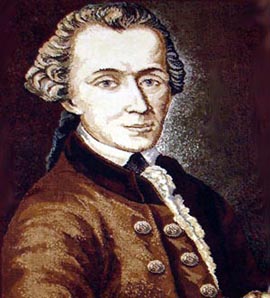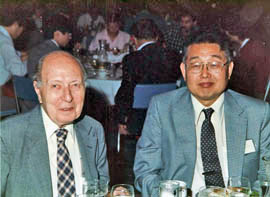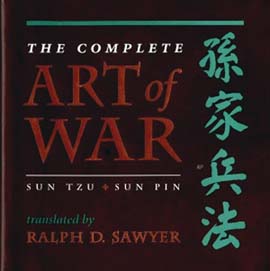Kantian Influence on Einstein
Y. S. Kim (2004.10.5)

|
| Portrait from the Kant Museum in Kaliningrad (Russia). |
Immanuel Kant
(1724-1804)
- Recent Photos from Kaliningrad ,
where he was born and lived for 80 years of his entire life.
-
Archived Article.
-
www.philosophypages.com/ph/kant.htm
Books and Articles on Kant. - How is Einsteism different from Kantianism?
1. Kantianism as a Product of Geography
-
Kant was born in the city of Koenigsberg. He spent his
entire life there. Do you know where this city is or was?
Like the Mediterranean Ocean, the Baltic Sea was the basin
of the civilization in its own area. About four hundred years
ago, Lithuania and Poland were very strong countries. There was
a Baltic costal area between these two countries, which became
one of the commercial centers strong enough to assert independence
from the two strong neighbors.
This place became a country called Prussia and became rich and strong enough to acquire some land west of Poland including Berlin. Then the center of gravity of Prussia moved to Germany, and the original Prussia became a province of Germany called "East Prussia." In Poland, this area is still called Prussia.

|
Let us look at the map containing both the Baltic and Black Seas (map from an old Webster World Atlas). Eastern and Western Europes are divided by a land strip between these two seas. There are no natural barriers between this broad borderland, and anyone with a strong army could walk into or walk through this area. Accordingly the city of Koenigsberg had been under many different managements.
There were native citizens in Koenigsberg like all other cities in the world. However, this city had to host many influential visitors with money or political powers. Koenigsberg had to entertain those coming with different viewpoints. There are many historians who carried out systematic investigations on Koenigsberg as the background for the philosophy formulated by Immanuel Kant. Here is an for an article on the history of this region.
2. Kantianism at work in Trieste
-
The city of Trieste is known to physicists as the home of the International
Center for Theoretical Physics. The center is about five kilometers away from
the downtown, and there is a bus connection along the beach where beautiful
girls swim and relax. When I was on the bus with my friend, it was about
60% full and I could see everybody including the driver. I told my friend
everybody on this bus in woman. He then told me it is so because my eyes can
detect only woman. I never found out whether it was so because there were only
women or because of measurement problems with my eyes.
After seeing the environment of Trieste, I told my colleagues at a dinner time that Trieste is an excellent city to stage a war. It has sea, mountains, islands, and beautiful ladies. Indeed, a perfect combination. Of course my comment outraged everybody, but military professionals would agree with me. In fact, generals chose this place for their wars in the past. Then what do I have in common with those military people? The answer is very simple. I was born and raised in Korea. When I was born Korea was hosting Japanese troops. American and Soviet troops after 1945. Then the Korean War (1950-53) before coming to the United States 1954 after my high school graduation. This means that my body and mind were configured in the war environment. I am still fond of collecting photos of war machines.
That is right. Observations depend on the observer's frame of mind. This is what Kantianism is all about, as far as physics is concerned. Let us go back to the first paragraph's of this section. My friend on the bus was physicist and he was preaching me modern physics, and also Kantianism. Indeed, modern physics is based on the philosophy based on Immanuel Kant.
3. Kantian Influence on Modern Physics
-
Unlike classical physics, modern physics depends heavily on observer's
state of mind or environment. The wave-particle duality is a product of
Kantianism. If your detectors can measure only particle properties,
particles behave like particles. On the other hand, if your detector
can detect only wave properties, particles behave like waves. Heisenberg
had come up with the uncertainty principle to reconcile these two different
interpretations. This question is still being debated, and is a lively
issue these days.
In special relativity, observers in different Lorentz frames see the same physical system differently. The importance of the observer's subjective viewpoint was emphasized by Immanuel Kant in his book entitled "Kritik der reinen Vernunft" whose first and second editions were published in 1781 and 1787 respectively. However, using his own logic, he ended up with a conclusion that there must be the absolute inertial frame, and that we only see the frames dictated by our subjectivity.
Einstein's special relativity was developed along Kant's line of thinking:
things depend on the frame from which you make observations. However,
there is one big difference. Instead of the absolute frame, Einstein
introduced an extra dimension. Let us illustrate this using a CocaCola
can. It appears like a circle if you look at it from the top, while
it appears as a rectangle from the side. The real thing is a
three-dimensional circular cylinder. While Kant was obsessed with
the absoluteness of the real thing, Einstein was able to observe the
importance of the extra dimension.
He added that philosophers do not dictate people how to think, but
their job is to describe systematically how people think. Here, Wigner
was talking about Immanuel Kant who formulated his philosophy based on
the thinking mode of Koenigsburg. Wigner's view of philosophers is
quite consistent with what Karl Marx
says on his tombstone at the Highgate Cemetery in London.
Wigner told me that I was the only person who asked him this question,
and asked me how I knew the Kantian way of reasoning was working in
his mind. I gave him the following answer.

4. Kantianism and Taoism
-
I never had any formal education in oriental philosophy, but I know
that my frame of thinking is affected by
my Korean background. One
important aspect is that Immanuel Kant's name is known to every
high-school graduate in Korea, while he is unknown to Americans,
particularly to American physicists. The question then is whether
there is in Eastern culture a ``natural frequency'' which can
resonate with one of the frequencies radiated from Kantianism developed
in Europe.
I would like to answer this question in the following way. Koreans absorbed a bulk of Chinese culture during the period of the Tang dynasty (618-907 AD). At that time, China was the center of the world as the United States is today. This dynasty's intellectual life was based on Taoism which tells us, among others, that everything in this universe has to be balanced between its plus (or bright) side and its minus (or dark) side. This way of thinking forces us to look at things from two different or opposite directions. This aspect of Taoism could constitute a ``natural frequency'' which can be tuned to the Kantian view of the world where things depend how they are observed.

|
Kant wrote his books in German, but he was born and spent his entire life in a Baltic enclave now called Kaliningrad located between Poland and Lithuania. Historically, this place was dominated by several different countries with different ideologies [2]. However, Kant's view was that the people there may appear differently depending on who look at them, but they remain unchanged. At the same time, they had to entertain different ideologies imposed by different rulers. Kant translated this philosophy into physics when he discussed the absolute and relative frames. He was obsessed with the absolute frame, and this is the reason why Kant is not regarded as a physicist in Einstein's world in which we live.
The people of Kant's land stayed in the same place while experiencing different ideological environments. Almost like Kant, I was exposed to two different cultural environments by moving myself from Asia to the United States. Thus, I often had to raise the question of absolute and relative values. Let us discuss this problem using one concrete example.

|
Shiyu is still respected in the Eastern world as one of the wisest men in history. We do not know whether this person existed or is a made-up personality. In either case, we are led to look for a similar person in the Western world. In ancient Greece, each city was run by its city council. As we experience even these days, people accomplish very little in committee meetings. Thus, it is safe to assume that the city councils in ancient Greece did not handle matters too efficiently. For this reason, there was a well-respected wiseman like Shiyu who never attended his city council meetings. His name was Idiot. Idiot was a wiseman, but he never contributed his wisdom to his community. His fellow citizens labeled him as a useless person. This was how the word idiot was developed in the Western world.
Idiot and Shiyu had the same personality if they were not the same person. However, Idiot is a useless person in state-centered societies like Sparta. The same person is regarded as the ultimate wiseman in a self-centered society like Korea. I cannot say that I know everything about other Asian countries, but I have a deep knowledge of Korea where I was born and raised. The same person looks quite differently to observers in different cultural frames. While doing research in the United States with my Eastern background, I was frequently forced to find a common ground for two seemingly different views.
This cultural background strongly influenced me in producing the further contents of Einstein's E = mc2 tabulated in the following table.
| ||||
| ||||
| ||||
|
Wigner liked this table very much, and this is the reason why I was able to maintain a relationship with him until he lost his memory power in 1991.
5. Relative Values
-
Let us go back to the question of relative values. For Taoists, those
two opposite faces of the same person is like ``yang'' (plus) versus
``ying'' (minus). Finding the harmony between these two opposite
points of view is the ideal way to live in this world. We cannot
always live like Shiyu, nor like Idiot. The key to happiness is to
find a harmony between the individual and the society to which
he/she belongs. The key word here seems to be ``harmony.''
- Y. Tanikawa, "Hideki Yukawa: Scientific Works" (Iwanami Shoten, Tokyo, 1979).
- A. Applebaum, "Between East and West, Across the Borderlands of Europe" (Pantheon Books, New York, 1994)
- Y. S. Kim, "Observable Gauge Transformations in the Parton Picture," Phys. Rev. Lett. vol.63, page 348 (1989).
- Sun Tzu and Sun Pin (translated by R. D. Sawyer), "The Complete Art of War" (Westview Press, Boulder, CO, 1996).
- Y. S. Kim, "Quarks and Partons as Two Different Manifestation of One Covariant Entity," Symmetries in Science VIII, edited by B. Gruber (Plenum, New York, 1995).
To Kantianists, however, it is quite natural for the same character to appear differently in two different environments. The problem is to find the absolute value from these two different faces. Does this absolute value exist? According to Kant, it exists. To most of us, it is very difficult to find it if it exists.
Let us finally visit Einstein. He avoids the question of the existence of the absolute value. Instead, he introduces a new variable. The variable is the ratio between the individual's ability to contribute and the community's need for his service. The best way to live in this world is to adjust this variable to the optimal value. Einstein's approach is to a quantification of Taoism by introducing a new variable.
If Taoism is so close to Einsteinism, why do we have to mention Kant at all? We have to keep in mind that Kant was the first person who formulated the idea that observers can participate in drawing the picture of the world. It is not clear whether Einstein could have formulated his relativity theory without Kant. Indeed, Kant spent many years for studying physics, namely observer-dependent physics. However, because of his obsession toward the absolute thing, he spent all of his time for finding the absolute frame. If one has a Taoist background, he/she is more likely to appreciate the concept of relativistic covariance.
I would like to stress that Taoism is not confined to the ancient Eastern world. It is practiced frequently in the United States. Let us look at American football games. The offensive strategy does not rely on brute force, but is aimed at breaking the harmony of the defense. For instance, when the offensive team is near the end zone, the defense becomes very strong because it covers only a small area. Then, it is not uncommon for the offense to place four wide-receivers instead of two. This will divide the defense into two sides while creating a hole in the middle. Then the quarter-back can carry the ball to the end zone. The key word is to destroy the balance of the defense.

|
I started my research on Einstein's Kantian connection in 1994 and included my first writing on this subject in one of the conference preceedings published in 1995 [5].
For an arxived article, click here.
Recent Photos from Kant's birth place, where he lived for 80 years.
Please visit www.philosophypages.com/ph/kant.htm for books and articles on Kant.
copyright@2004 by Y. S. Kim, unless otherwise specified. Map of Kaliningrad/ Koenigsberg from this book.